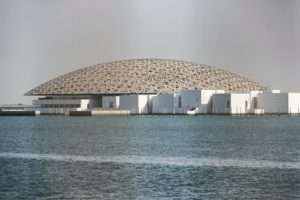 Louvre Abu Dhabi, the first universal museum in the Arab world, opened its doors to the public on Saturday 8 November 2017. The opening celebration certainly did not disappoint them, as the historic moment was marked by colourful, cultural events and performances.
Louvre Abu Dhabi, the first universal museum in the Arab world, opened its doors to the public on Saturday 8 November 2017. The opening celebration certainly did not disappoint them, as the historic moment was marked by colourful, cultural events and performances.
On that day, hundreds of people from all over the UAE descended on Saadiyat Island hoping to get in early before the madness began.
The lineup of different cultural celebrations, reflected on the vision of what the museum actually stands for united people from all walks of life, uniting the cultures and nationalities and bringing them together as one – just as the museum has brought together treasured artwork from every corner of our world.
Manuel Rabate, director of Louvre Abu Dhabi, welcomed the first excited visitors at the museum.
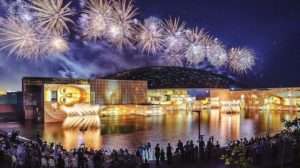 Just as the doors were opening, a traditional UAE performance, ‘Al Ayyala,’ by Mubarak Al Otaiba’s group, gave a special taste of the nation’s unique culture and heritage to the visitors. Al Ayyala, which has been recognised by Unesco as a Living Intangible Heritage since 2014, is often performed at national events, festive occasions and weddings across the UAE.
Just as the doors were opening, a traditional UAE performance, ‘Al Ayyala,’ by Mubarak Al Otaiba’s group, gave a special taste of the nation’s unique culture and heritage to the visitors. Al Ayyala, which has been recognised by Unesco as a Living Intangible Heritage since 2014, is often performed at national events, festive occasions and weddings across the UAE.
On the eve of the opening day, French pyrotechnic wizards Groupe F performed a jaw-dropping audio-visual light show titled Museum Reflections. The dramatic and innovative show took the audience on a voyage of discovery in four parts: from the depths of the water to the surface of the sea, onto the ground, and finally up into the skies.
Crowds watched, as each act revealed masterpieces from Louvre Abu Dhabi’s collection, which were stunningly projected across the building under an incredible firework display that lit up the night sky of the UAE Capital.
Meanwhile, throughout Saturday, Lucinda Childs, a major figure in contemporary dance, surprised visitors with her incredible dance moves, which she performed inside the galleries. The artiste gave visitors a glimpse of a performance that reflected on the notion of space and time overpowering all other elements.
During the afternoon, a Dogon masked dance by Awa Troupe of Sangha, took place inside the museum. Hundreds of visitors watched, as the men from Mali led a parade, accompanied by drummers and musicians. Even children that were visiting the museum took part with the 15 West African dancers, and showed off their acrobatic dance moves to the crowds, who just about all had their cameras out, capturing moments of culture before their eyes.
Another traditional performance took place around the plaza – this time, showcasing Chinese parade of lions and dragons. A whirlwind of colourful energy and noise sprung around the museum, as two popular Chinese dances were performed by the troupe of Zhejiang Wu Opera Research Centre.
Before the evening took over and the finest Korean ensembles impressed some more crowds, a soothing performance by Emirati composer and musician, Faisal Al Saari. The self-taught artist’s harmonic instrumental play did not distract audiences as they gazed over the pieces in the galleries, but rather, gave an unexplained ambiguity that somehow worked beautifully and hand-in-hand with the treasured artworks.
Louvre Abu Dhabi has already brought the world in one place, without-a-doubt proved that although the East and West may not all share the same life – they still share the same world. And as the sun went down, and an airy night awakened, there was perhaps one performance that continued to impress Louvre Abu Dhabi’s visitors. A performance that had no sound, had no dance, and no effort, a solo performer – Jean Nouvel’s magnificent ‘Rain of Light.’
Five things not to miss at Louvre Abu Dhabi
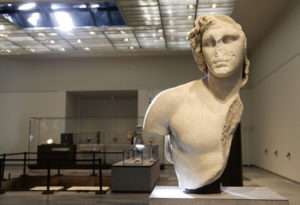
A statue of Alexander the Great, frames a colonnade of Roman busts that include several emperors.
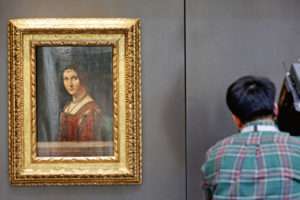
Portrait of a Woman, named La Belle Ferronniere by Lenoardo Da Vinci.
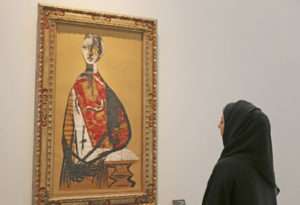
Portrait of a Woman by Pablo Picasso, done in France,1928
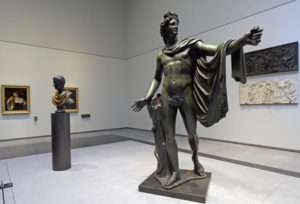
The Belvedere Apollo (1542-1543) in Bronze by Francesco Primaticcio at Louvre Abu Dhabi.
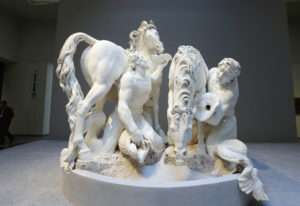
Horses of the Sun by Gilles Guerin, France, 1668-1675 on display at Louvre Abu Dhabi. (Photos by Ryan Lim, AFP)
How to get there
From Abu Dhabi
Take Sheikh Khalifa Bin Zayed Highway (E12), which can be accessed from Corniche Road or Hamdan Bin Mohammed Street or Zayed the First Street. Take exit right after Sheikh Khalifa Bridge to the museum.
From Dubai
Start on the Sheikh Maktoum Bin Rashid Road (E11) and take Abu Dhabi-Shahama Road (E10). Switch to Sheikh Khalifa Bin Zayed Highway and take exit before Sheikh Khalifa Bridge.Taxi fare from Abu Dhabi city will cost between Dh30 and Dh40Catch these buses to get there: Numbers 192 and 193
Museum Timings
Saturday, Sunday, Tuesday and Wednesday: 10am to 10pm
Thursday and Friday: 10am to 11pm
Monday closed
Ticket Costs
Dh60 – for those aged above 22 years
Dh30 – for those aged between 13 and 22 years
Free entry – for children aged 13 and under